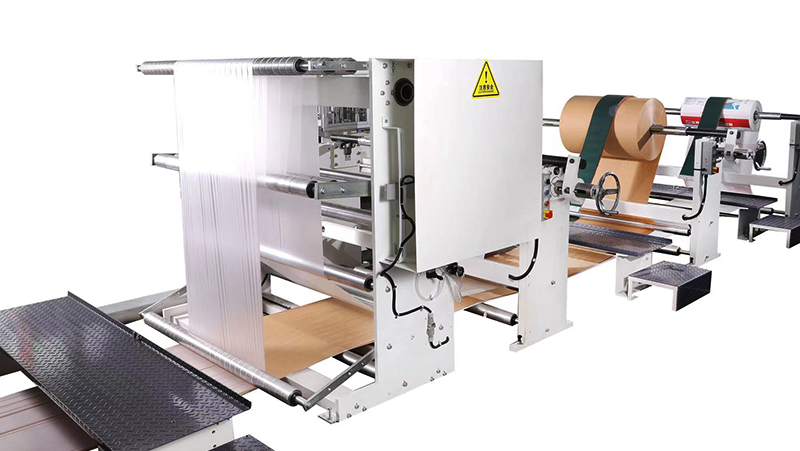How Paper Bag Making Machines Work: A Comprehensive Guide to Production Processes and Benefits
Release time:2025-04-28 Classification:Knowledge
Paper bag making machines are essential equipment in the packaging industry, designed to efficiently produce eco-friendly and customizable paper bags for retail, grocery, and promotional uses. These machines combine precision engineering with automation to meet the growing demand for sustainable packaging solutions. Below is an in-depth look at their functionality, advantages, and applications.

1. Overview of Paper Bag Making Machines
A paper bag making machine automates the conversion of paper rolls into finished bags. It streamlines processes such as printing, cutting, folding, gluing, and handle attachment, ensuring high-speed production with minimal waste. These machines cater to various bag types, including flat, satchel, and twisted-handle bags, and can handle materials like kraft paper, recycled paper, or laminated sheets.
2. Key Components and Operation
- Unwinding Unit: Feeds paper rolls into the machine.
- Printing Section: Applies designs, logos, or text using flexographic or offset printing.
- Cutting and Creasing: Precision blades cut paper into sheets and create fold lines.
- Folding and Gluing: Forms the bag structure by folding edges and applying adhesive.
- Handle Attachment: Adds rope, flat, or twisted handles (optional for certain models).
- Stacking and Output: Collects finished bags for packaging.
Modern machines often feature PLC (Programmable Logic Controller) systems for customizable settings, ensuring consistency across batches.
3. Production Process Breakdown
- Material Loading: Paper rolls are mounted onto the unwinder.
- Printing: Designs are applied in single or multiple colors.
- Sheet Formation: Paper is cut into predefined sizes.
- Bottom Sealing: The base is folded and glued for durability.
- Side Folding and Gluing: Sides are sealed to form the bag shape.
- Handle Integration: Handles are attached if required.
- Quality Inspection: Sensors detect defects, ensuring only flawless bags proceed.
- Output: Finished bags are counted and stacked.
4. Advantages of Automated Paper Bag Production
- Efficiency: High-speed output (up to 150 bags per minute) reduces labor costs.
- Customization: Adjustable settings for size, design, and handle types.
- Sustainability: Minimizes material waste and supports eco-friendly packaging trends.
- Consistency: Ensures uniform quality across large orders.
- Scalability: Suitable for small businesses and large-scale manufacturers.
5. Applications of Paper Bags
- Retail: Branded shopping bags for clothing, cosmetics, and luxury goods.
- Food Industry: Grocery bags, takeaway packaging, and bakery pouches.
- Promotional Events: Custom-printed bags for conferences, weddings, or trade shows.
- E-commerce: Durable packaging for shipping products.
6. Choosing the Right Machine
When selecting a paper bag making machine, consider:
- Production Capacity: Match speed and output to business needs.
- Versatility: Ability to handle different paper weights and bag styles.
- Automation Level: Semi-automatic vs. fully automatic models.
- Energy Efficiency: Machines with reduced power consumption lower operational costs.
- After-Sales Support: Availability of technical assistance and spare parts.
7. Maintenance Tips
- Regularly clean glue nozzles and cutting blades to prevent clogging.
- Lubricate moving parts as per the manufacturer’s guidelines.
- Inspect sensors and electrical components for optimal performance.
- Train operators on safety protocols and troubleshooting basics.
8. Future Trends in Paper Bag Manufacturing
Innovations such as AI-driven quality control, energy-efficient motors, and modular designs are shaping the industry. Additionally, demand for water-based adhesives and biodegradable materials aligns with global sustainability goals.
Conclusion
Paper bag making machines are pivotal in meeting the shift toward green packaging. By automating production, businesses achieve cost-effective, scalable, and environmentally responsible solutions. Investing in advanced machinery not only enhances operational efficiency but also positions companies to thrive in a competitive, eco-conscious market.
This guide provides a technical yet accessible overview of paper bag making machines, emphasizing their role in sustainable manufacturing. For optimal results, pair these machines with high-quality raw materials and regular maintenance routines.






